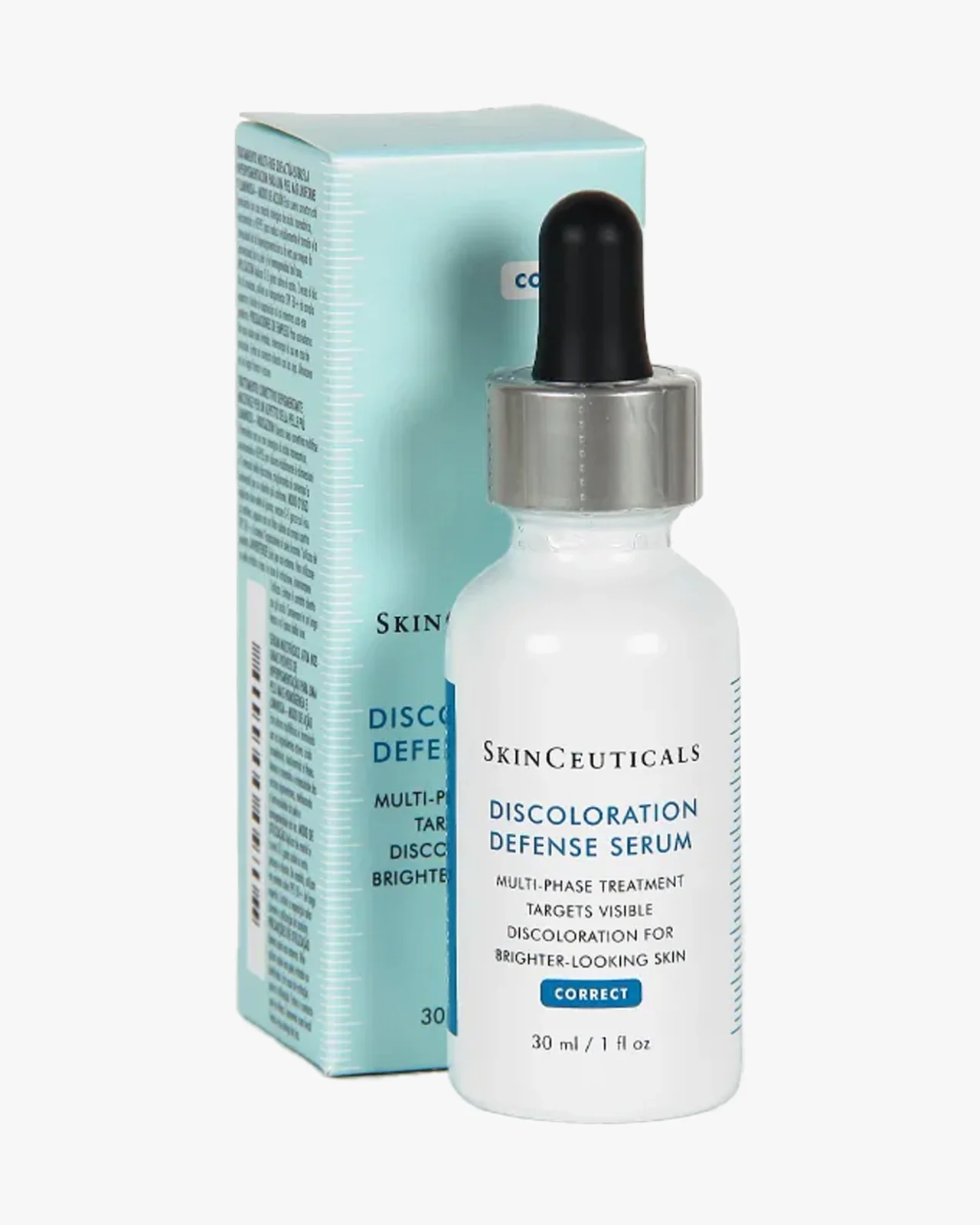What’s the Difference Between Melasma and Hyperpigmentation?
Dermatologists reveal what sets the two skin concerns apart and what you can do to treat them.
By Loren Savini and Leira Aquino
Remember this one? “All whole numbers are integers, but not all integers are whole numbers.” Believe it or not, this math class gem is the perfect way to understand the difference between two related-but-not-completely skin conditions: melasma and hyperpigmentation. (Write your grade school math teacher and thank them for the skin care lesson!)
Hyperpigmentation refers to any discoloration of the skin—be it an acne scar, sun damage, freckles, age spots, or a condition like melasma. Melasma is a type of hyperpigmentation, but it typically stems from different causes, which means we have to treat it a little differently. Put another way: All melasma is hyperpigmentation, but not all hyperpigmentation is melasma. Unfortunately, it can be tricky to differentiate between regular ol’ hyperpigmentation and melasma because they essentially present the same way.
To demystify this tricky skin condition, we spoke to four dermatologists about the differences between melasma and hyperpigmentation, what causes them, and how to treat both.
Meet the Experts:
Anna Palabyab-Rufino, MD, is a board-certified dermatologist based in Manila.
Dhaval Bhanusali, MD, is a board-certified dermatologist based in New York City.
Michele Farber, MD, is a board-certified dermatologist with the Schweiger Dermatologist Group in Philadelphia.
Anthony Rossi, MD, is a board-certified dermatologist and Mohs surgeon at Memorial Sloan Kettering in New York City.
Adam Friedman is an associate professor of dermatology at George Washington University Medical Faculty Associates in Washington, D.C.
What is hyperpigmentation?
“Hyperpigmentation is any darkening in skin pigment due to an increase in melanin,” says Philadelphia-based board-certified dermatologist Michele Farber, MD. “This can be from inflammatory conditions like acne or eczema, injury to the skin, hormonal conditions, medications, and sunlight.”
This is because acne, sunlight, and skin rashes have the potential to stimulate melanocytes— the pigment-making cells in the skin—to make a surplus of pigment. This then causes the melanocytes to “dump their pigment into lower levels of the skin, like tattoo pigment, where it doesn’t belong,” explains Adam Friedman, MD, an associate professor of dermatology at George Washington University Medical Faculty Associates in Washington, D.C. This results in discoloration of the skin, in what appears to be patches or freckles.
Hyperpigmentation causes
Post-blemish scarring from a stubborn breakout, freckles that expanded into full-blown sun spots from excess exposure, or discoloration caused by a condition like eczema or psoriasis usually all fall under the umbrella of hyperpigmentation.
What is melasma?
Melasma is a common skin condition in which the body overproduces melanin, creating dark brown patches of pigment—typically on the face, forehead, upper cheeks, and around the mouth. “More often than not, you’ll see it on the cheeks,” says Manila-based board-certified dermatologist Anna Palabyab-Rufino. “You’ll [also] see it sometimes on the upper lip.” This discoloration is also known as hyperpigmentation. Remember: All melasma is hyperpigmentation, but not all hyperpigmentation is melasma.
Melasma causes
Melasma can be triggered by a number of external factors like sun exposure, heat, or skin trauma. But the real culprits here are hormones. Melasma mostly affects women—and is sometimes referred to as “the mask of pregnancy,” as it frequently appears during pregnancy due to the vast hormonal changes. It can also be triggered by birth control or hormonal therapies. “It could be a result of poor sun protection, and sometimes hormonal changes during pregnancy,” explains Dr. Palabyab-Rufino. “It could also be a result of taking oral contraceptives, [which is] again hormonal in its cause,” she adds.
It can even be genetic. If melasma is present in one’s family—such as in a parent, according to Dr. Palabyab-Rufino—there may be an increased risk of developing it. In such cases, it’s important to be proactive about prevention to avoid worsening the condition.
Melasma and hyperpigmentation: How to tell the difference
It can be difficult to tell the difference between melasma and regular hyperpigmentation because they both appear as dark patches of pigment. But there are a few clues to help you suss out the difference.
First is your history. “With a trained eye, along with proper history-taking and investigation, you [can usually determine the difference],” Dr. Palabyab-Rufino says. This includes assessing recent sun exposure and checking for any history of inflammation in the affected area, she adds. Moreover, it’s important to ask yourself: Are you on any medications or therapies that cause fluctuation in your hormones? If so, you may be dealing with melasma. If you grew up with the habit of baking in the sun with no sunscreen (tsk, tsk), the spots across your face are likely hyperpigmentation.
The patch pattern can also help you determine if you have melasma or hyperpigmentation. “For the ordinary person who didn’t study this, you would still see patterns. [Melasma] is more map-like, rather than, let’s say, a spot from a pimple or a wound,” Dr. Palabyab-Rufino says.
“Hyperpigmentation is usually very focused, whereas melasma appears as broad patches with intervening areas of clearing,” affirms Anthony Rossi, MD, a board-certified dermatologist in New York City. Melasma also tends to be more symmetrical.
The coloring can also be different, Dr. Palabyab-Rufino points out. “[In] melasma, sometimes, it’s mixed with reddish vascularities in the patch itself,” she elaborates.
Dr. Palabyab-Rufino also emphasizes that while some signs might seem easy to identify, it’s still best to see a dermatologist to accurately determine whether you’re dealing with melasma or another form of pigmentation. A proper consultation helps ensure you ask the right questions and receive expert guidance on how to manage it.
Treatments for melasma
In order to treat melasma, you have to understand what’s causing it and reverse course on that behavior. Unfortunately, because it is largely caused by hormonal fluctuations, that can be hard to do. “Melasma is a very challenging condition to treat,” Dr. Palabyab-Rufino says. She also notes that treatment options during pregnancy are quite limited, which makes it all the more important to seek professional guidance and proceed with caution.
For a person whose melasma is caused by contraceptives, meanwhile, “it’s helpful to stop birth control if you are getting melasma, but that’s not always a practical solution,” says Dr. Farber. If removing the instigating factors isn’t an option, what you really want to do is prevent the dark patches from worsening.
Retinoids: Is there anything you can’t solve with retinoids? (Yes, but that’s not why we’re here). “Retinoids promote skin cell turnover which can help even skin tone,” says Dr. Farber. However, retinoids are not recommended during pregnancy — so if that’s the root cause of your melasma, you’ll have to wait on this one.
Low-potency steroids: Dermatologist-prescribed, low-potency, topical steroids (like hydrocortisone) can help with inflammation, which in turn can fade the patches of dark pigment.
Treatments for hyperpigmentation
There is a lot of overlap in the treatment options for melasma and hyperpigmentation since you’re targeting the same thing—patches of concentrated or darkened pigment. In fact, retinoids and low-potency steroids are all great options for anyone experiencing hyperpigmentation. But generally, hyperpigmentation is more likely to respond to over-the-counter products or aesthetic treatments—especially if the hyperpigmentation is caused by scarring or sun exposure (as opposed to hormones or straight up genetics).
Vitamin C: If you’ve been dealing with sun damage, or even if you’ve been on the hunt for “brightening” products, you probably already have this ingredient in rotation. Vitamin C can decrease melanin synthesis — meaning it will slow down any darkening — and can even out skin tone.
Chemical peels: In-clinic chemical peels can help to remove layers of the epidermis that have darkened due to hyperpigmentation.
Laser treatments: Like chemical peels, laser peels or skin resurfacing can either remove damaged layers of skin (ablative lasers) or promote collagen growth and cell turnover (non-ablative lasers)—both of which can dull dark patches or scars. “1927nm non-ablative lasers and pico lasers are particularly good and safe on most skin types,” says Dr. Bhanusali.
Products that can help treat hyperpigmentation are usually beneficial for multiple reasons (vitamin C is a powerful antioxidant and boosts collagen, for example). In addition to vitamin C, Dr. Farber recommends looking for products that feature azelaic, tranexamic, and kojic acids. He recommends SkinCeuticals Discoloration Defense, a daily serum that features both tranexamic and kojic acids to reduce dark pigment.

Sun protection is essential
You can’t treat or prevent melasma or hyperpigmentation without sun protection. Melasma may also be triggered by hormonal factors, but that does not mean you should slack off on the SPF, as UV rays are still responsible for magnifying the condition.
“Seek shade, avoid the sun between 10 P.M. and 2 P.M., and consistently apply and reapply mineral sunscreen,” says Dr. Farber.




